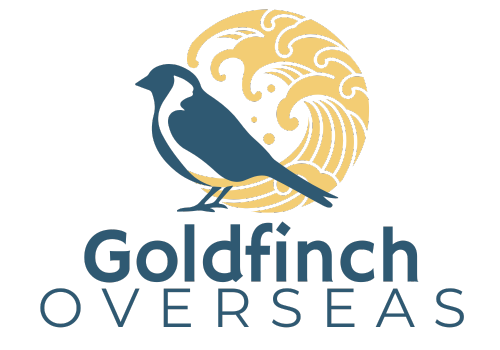Morocco’s imperial cities are a testament to the country’s deep-rooted history, blending Moorish heritage, Islamic architecture, and vibrant cultural traditions. Each city, once a capital of a ruling dynasty, showcases grand palaces, majestic mosques, and labyrinthine medinas that tell the story of Morocco’s evolution over centuries. These cities—Marrakech, Fes, Meknes, and Rabat—offer travelers an unparalleled journey through time, where ancient walls guard centuries-old secrets, and lively souks bring the past to life.
Marrakech – The Red City
Marrakech, known as the “Red City” due to its terracotta-hued walls and buildings, was founded in 1062 by the Almoravid dynasty. Over the centuries, it has remained a vital cultural and economic hub, attracting travelers, traders, and scholars alike.
The Medina and Jemaa el-Fnaa
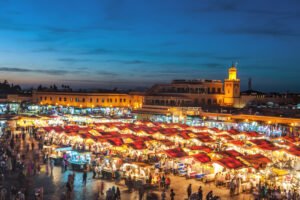
Famous Djemaa El Fna Square in early evening light, Marrakech, Morocco with the Koutoubia Mosque.
At the heart of Marrakech lies its UNESCO-listed medina, a maze of narrow alleyways lined with bustling souks, traditional riads, and architectural marvels. The famous Jemaa el-Fnaa square is a sensory overload, filled with snake charmers, storytellers, musicians, and food stalls that offer everything from sizzling meats to sweet mint tea. As night falls, the square transforms into an open-air theatre of Moroccan life, where both locals and visitors gather to experience the city’s pulse.
Majestic Palaces and Gardens
Marrakech boasts some of Morocco’s most stunning palaces, including the Bahia Palace, an opulent 19th-century residence adorned with intricate zellij tiles, carved wooden ceilings, and lush courtyards. The El Badi Palace, once a symbol of Saadian power, now stands in magnificent ruins, offering a glimpse into its former grandeur. For a moment of tranquility, the Majorelle Garden, created by French painter Jacques Majorelle and later restored by Yves Saint Laurent, is a stunning oasis of cobalt blue accents and exotic plants.
A Gateway to Adventure
Marrakech serves as a perfect base for excursions beyond the city. The Atlas Mountains, just a short drive away, offer breathtaking landscapes, while desert tours to Merzouga promise unforgettable camel treks and nights under the stars in luxury desert camps.
Fes – The Spiritual and Cultural Capital
If Marrakech is Morocco’s vibrant heart, Fes is its soul. As the country’s oldest imperial city, Fes is often considered the spiritual and intellectual capital, home to the world’s oldest university and some of the finest examples of Islamic architecture.
Fes el-Bali: A Living Museum
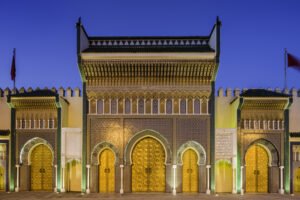
The Royal Palace gate inside medina of Fez, Morocco.
The medieval medina of Fes el-Bali, a UNESCO World Heritage site, is one of the best-preserved historic towns in the world. With over 9,000 alleyways, it’s a labyrinth filled with madrasas, mosques, and bustling souks. Walking through its ancient streets is like stepping back in time, where donkeys still transport goods, craftsmen shape leather and brass using centuries-old techniques, and the call to prayer echoes through the city.
The Al-Qarawiyyin University and Madrasa Bou Inania
Founded in 859 AD, Al-Qarawiyyin University is recognized as the world’s oldest continuously operating university. It has been a center of learning for scholars from across the Islamic world, Europe, and Africa. Nearby, the Madrasa Bou Inania showcases exquisite Moroccan craftsmanship, with its intricate plasterwork, cedarwood carvings, and mesmerizing tile mosaics.
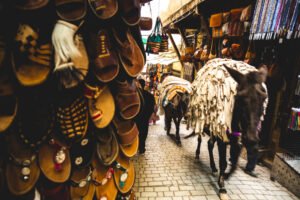
Mule transportation in Fez Medina streets, Morocco.
The Chouara Tanneries
Fes is famous for its ancient tanneries, where leather is dyed using traditional methods that have remained unchanged for centuries. Visitors can watch the fascinating (and aromatic) process from surrounding terraces, where vibrant pits of natural dyes create a striking visual spectacle.
Meknes – The Forgotten Jewel
Often overshadowed by its more famous neighbors, Meknes is a hidden gem among Morocco’s imperial cities. Founded in the 17th century by Sultan Moulay Ismail, this city was envisioned as Morocco’s “Versailles,” with grand architecture and formidable fortifications.
The Grand Gates and City Walls
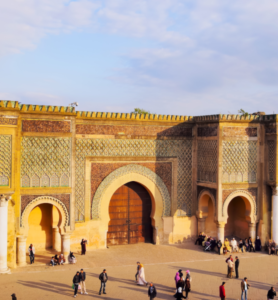
Bab Mansour cultural museum in Meknes, taken from Place El Haddim.
Meknes is known for its impressive gates, particularly Bab Mansour, considered one of the most beautiful gates in Morocco. Adorned with zellij tilework and carved inscriptions, this monumental entrance stands as a reminder of the city’s glorious past. Surrounding Meknes, 40 kilometers of well-preserved city walls once defended the Sultan’s ambitious empire.
The Royal Stables and Granaries
One of Meknes’ most fascinating sites is the Heri es-Souani, a vast granary and stable complex built to house thousands of horses. The enormous stone chambers, designed to keep grain cool, demonstrate the engineering prowess of Moulay Ismail’s era.
The Mausoleum of Moulay Ismail
As the final resting place of the Sultan who transformed Meknes into a grand capital, the Mausoleum of Moulay Ismail is a place of serene beauty. Unlike many religious sites in Morocco, this mausoleum welcomes non-Muslim visitors, allowing them to admire its ornate courtyards and intricate stucco work.
Rabat – The Modern Capital with Imperial Roots
Rabat, Morocco’s present-day capital, seamlessly blends modernity with historical grandeur. As an imperial city, it reflects a rich past while serving as the political and administrative heart of the country.
The Hassan Tower and Mausoleum of Mohammed V
One of Rabat’s most iconic landmarks is the Hassan Tower, an unfinished minaret of what was meant to be the largest mosque in the Islamic world. Though construction ceased in the 12th century, the site remains a striking architectural marvel. Adjacent to it lies the Mausoleum of Mohammed V, a masterpiece of white marble and green-tiled roofs, housing the tombs of Morocco’s beloved monarchs.
The Kasbah of the Udayas
Overlooking the Atlantic Ocean, the Kasbah of the Udayas is a picturesque fortress with white-and-blue-washed walls reminiscent of Chefchaouen. Inside, narrow alleyways lead to tranquil gardens and panoramic views, offering a peaceful retreat from the city’s modern bustle.
A Fusion of Old and New
Unlike other imperial cities, Rabat embraces a more contemporary lifestyle. The Medina of Rabat is smaller and less chaotic than those of Fes or Marrakech, making it a pleasant place to explore. Meanwhile, the city’s boulevards, embassies, and waterfront developments showcase Morocco’s aspirations for the future.
The imperial cities of Morocco each tell a unique chapter of the nation’s history, from Marrakech’s vibrant souks to Fes’ scholarly traditions, Meknes’ royal ambitions, and Rabat’s modern elegance. Visiting these cities is a journey through Morocco’s past and present, where architectural splendor, cultural heritage, and lively traditions intertwine. Whether you are captivated by ancient medinas, intrigued by the legacy of sultans, or drawn to Morocco’s evolving identity, these imperial cities offer an unforgettable experience.
